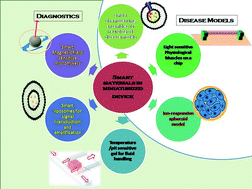Smart material platforms for miniaturized devices: implications in disease models and diagnostics
Abstract
Smart materials are responsive to multiple stimuli like light, temperature, pH and redox reactions with specific changes in state. Various functionalities in miniaturised devices can be achieved through the application of “smart materials” that respond to changes in their surroundings. The change in state of the materials in the presence of a stimulus may be used for on demand alteration of flow patterns in devices, acting as microvalves, as scaffolds for cellular aggregation or as modalities for signal amplification. In this review, we discuss the concepts of smart trigger responsive materials and their applications in miniaturized devices both for organ-on-a-chip disease models and for point-of-care diagnostics. The emphasis is on leveraging the smartness of these materials for example, to allow on demand sample actuation, ion dependent spheroid models for cancer or light dependent contractility of muscle films for organ-on-a-chip applications. The review throws light on the current status, scope for technological enhancements, challenges for translation and future prospects of increased incorporation of smart materials as integral parts of miniaturized devices.

- This article is part of the themed collection: Lab on a Chip Recent Review Articles


 Please wait while we load your content...
Please wait while we load your content...